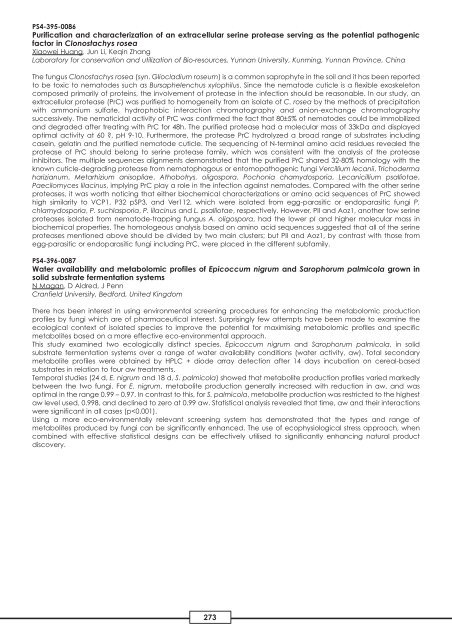Handbook Part 2 - International Mycological Association
Handbook Part 2 - International Mycological Association
Handbook Part 2 - International Mycological Association
You also want an ePaper? Increase the reach of your titles
YUMPU automatically turns print PDFs into web optimized ePapers that Google loves.
PS4-395-0086<br />
Purification and characterization of an extracellular serine protease serving as the potential pathogenic<br />
factor in Clonostachys rosea<br />
Xiaowei Huang, Jun Li, Keqin Zhang<br />
Laboratory for conservation and utilization of Bio-resources, Yunnan University, Kunming, Yunnan Province, China<br />
The fungus Clonostachys rosea (syn. Gliocladium roseum) is a common saprophyte in the soil and it has been reported<br />
to be toxic to nematodes such as Bursaphelenchus xylophilus. Since the nematode cuticle is a flexible exoskeleton<br />
composed primarily of proteins, the involvement of protease in the infection should be reasonable. In our study, an<br />
extracellular protease (PrC) was purified to homogeneity from an isolate of C. rosea by the methods of precipitation<br />
with ammonium sulfate, hydrophobic interaction chromatography and anion-exchange chromatography<br />
successively. The nematicidal activity of PrC was confirmed the fact that 80±5% of nematodes could be immobilized<br />
and degraded after treating with PrC for 48h. The purified protease had a molecular mass of 33kDa and displayed<br />
optimal activity at 60 ?, pH 9-10. Furthermore, the protease PrC hydrolyzed a broad range of substrates including<br />
casein, gelatin and the purified nematode cuticle. The sequencing of N-terminal amino acid residues revealed the<br />
protease of PrC should belong to serine protease family, which was consistent with the analysis of the protease<br />
inhibitors. The multiple sequences alignments demonstrated that the purified PrC shared 32-80% homology with the<br />
known cuticle-degrading protease from nematophagous or entomopathogenic fungi Vercillium lecanii, Trichoderma<br />
harizianum, Metarhizium anisopliae, Athobotrys. oligospora, Pochonia chamydosporia, Lecanicillium psalliotae,<br />
Paecilomyces lilacinus, implying PrC play a role in the infection against nematodes. Compared with the other serine<br />
proteases, it was worth noticing that either biochemical characterizations or amino acid sequences of PrC showed<br />
high similarity to VCP1, P32 pSP3, and Ver112, which were isolated from egg-parasitic or endoparasitic fungi P.<br />
chlamydosporia, P. suchlasporia, P. lilacinus and L. psalliotae, respectively. However, PII and Aoz1, another tow serine<br />
proteases isolated from nematode-trapping fungus A. oligospora, had the lower pI and higher molecular mass in<br />
biochemical properties. The homologeous analysis based on amino acid sequences suggested that all of the serine<br />
proteases mentioned above should be divided by two main clusters; but PII and Aoz1, by contrast with those from<br />
egg-parasitic or endoparasitic fungi including PrC, were placed in the different subfamily.<br />
PS4-396-0087<br />
Water availability and metabolomic profiles of Epicoccum nigrum and Sarophorum palmicola grown in<br />
solid substrate fermentation systems<br />
N Magan, D Aldred, J Penn<br />
Cranfield University, Bedford, United Kingdom<br />
There has been interest in using environmental screening procedures for enhancing the metabolomic production<br />
profiles by fungi which are of pharmaceutical interest. Surprisingly few attempts have been made to examine the<br />
ecological context of isolated species to improve the potential for maximising metabolomic profiles and specific<br />
metabolites based on a more effective eco-environmental approach.<br />
This study examined two ecologically distinct species, Epicoccum nigrum and Sarophorum palmicola, in solid<br />
substrate fermentation systems over a range of water availability conditions (water activity, aw). Total secondary<br />
metabolite profiles were obtained by HPLC + diode array detection after 14 days incubation on cereal-based<br />
substrates in relation to four aw treatments.<br />
Temporal studies (24 d, E. nigrum and 18 d, S. palmicola) showed that metabolite production profiles varied markedly<br />
between the two fungi. For E. nigrum, metabolite production generally increased with reduction in aw, and was<br />
optimal in the range 0.99 – 0.97. In contrast to this, for S. palmicola, metabolite production was restricted to the highest<br />
aw level used, 0.998, and declined to zero at 0.99 aw. Statistical analysis revealed that time, aw and their interactions<br />
were significant in all cases (p









